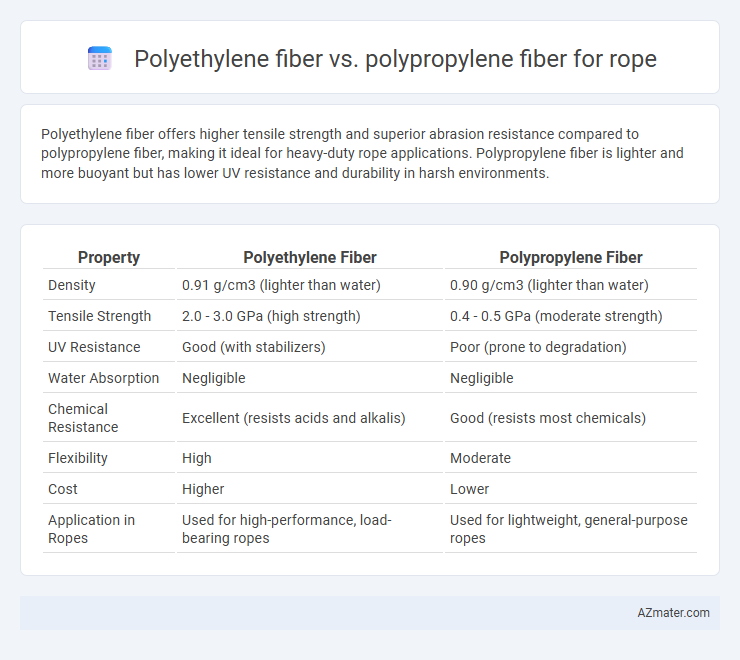Polyethylene fiber offers higher tensile strength and superior abrasion resistance compared to polypropylene fiber, making it ideal for heavy-duty rope applications. Polypropylene fiber is lighter and more buoyant but has lower UV resistance and durability in harsh environments.
Table of Comparison
| Property | Polyethylene Fiber | Polypropylene Fiber |
|---|---|---|
| Density | 0.91 g/cm3 (lighter than water) | 0.90 g/cm3 (lighter than water) |
| Tensile Strength | 2.0 - 3.0 GPa (high strength) | 0.4 - 0.5 GPa (moderate strength) |
| UV Resistance | Good (with stabilizers) | Poor (prone to degradation) |
| Water Absorption | Negligible | Negligible |
| Chemical Resistance | Excellent (resists acids and alkalis) | Good (resists most chemicals) |
| Flexibility | High | Moderate |
| Cost | Higher | Lower |
| Application in Ropes | Used for high-performance, load-bearing ropes | Used for lightweight, general-purpose ropes |
Overview of Polyethylene and Polypropylene Fibers
Polyethylene fibers, known for their high tensile strength and low density, offer excellent resistance to chemicals and UV degradation, making them ideal for lightweight, durable ropes. Polypropylene fibers provide good moisture resistance and buoyancy, with a lower melting point and lesser abrasion resistance compared to polyethylene. Both fibers are widely used in rope manufacturing, but polyethylene is favored in applications requiring superior strength and environmental resistance.
Chemical Structure Differences
Polyethylene fiber consists of long chains of ethylene monomers with a simple linear structure, providing high tensile strength and excellent chemical resistance to acids and bases. Polypropylene fiber is composed of propylene monomers with a methyl group attached to every other carbon atom, resulting in a slightly more rigid structure that offers good resistance to moisture and alkalis but lower UV stability. These chemical structure differences influence their durability, flexibility, and resistance to environmental factors when used in rope applications.
Strength and Durability Comparison
Polyethylene fiber exhibits higher tensile strength and superior abrasion resistance compared to polypropylene fiber, making it ideal for ropes that require maximum durability under heavy loads. Polyethylene fibers also offer excellent resistance to UV radiation and chemicals, which extends their lifespan in outdoor and marine environments. In contrast, polypropylene fiber is lighter and more cost-effective but has lower strength and is more prone to degradation when exposed to sunlight and harsh conditions.
Water Absorption and Floatation Properties
Polyethylene fiber exhibits extremely low water absorption, typically below 0.01%, making it highly resistant to moisture and ideal for marine rope applications where buoyancy is critical. In contrast, polypropylene fiber also has low water absorption, around 0.04%, but is slightly higher than polyethylene, which contributes to its excellent floatation properties due to its lower density than water. Both fibers resist water degradation, but polyethylene's superior moisture resistance and buoyancy make it preferable for ropes requiring extended exposure to wet environments and reliable floatation.
UV and Chemical Resistance
Polypropylene fiber exhibits superior UV resistance compared to polyethylene fiber, making it ideal for rope applications exposed to prolonged sunlight. Both fibers offer good chemical resistance, but polypropylene shows enhanced durability against acids and alkalis, whereas polyethylene is more resistant to organic solvents and oils. Choosing between them depends on the specific environmental exposure and chemical factors where the rope will be used.
Flexibility and Handling
Polyethylene fiber offers superior flexibility and softness, making it easier to handle and knot compared to polypropylene fiber, which tends to be stiffer and less pliable. The enhanced flexibility of polyethylene ropes reduces hand fatigue during prolonged use and improves overall maneuverability in applications such as climbing or marine activities. Polypropylene fiber's lower flexibility may limit its usability in situations requiring frequent manipulation or tight knots.
Weight and Density Variations
Polyethylene fiber ropes exhibit a lower density of approximately 0.91 g/cm3, making them lighter and ideal for applications requiring buoyancy, while polypropylene fibers have a density around 0.90 g/cm3, also lightweight but slightly less resistant to UV degradation. The minimal weight difference allows both fibers to offer exceptional strength-to-weight ratios, yet polyethylene fibers typically provide superior abrasion resistance and durability in harsh environments. Polypropylene ropes, being lighter and less dense, are often favored for cost-effective, general-purpose uses where extreme mechanical performance is not critical.
Cost Efficiency and Availability
Polypropylene fiber ropes are generally more cost-efficient and widely available compared to polyethylene fiber ropes, making them a popular choice for budget-sensitive projects. Polyethylene fiber, such as UHMWPE (Ultra-High-Molecular-Weight Polyethylene), offers superior strength and abrasion resistance but comes with a higher price point and limited availability. For applications prioritizing cost and accessibility, polypropylene fibers provide an optimal balance without compromising basic durability.
Common Applications in Rope Manufacturing
Polyethylene fiber, known for its high strength-to-weight ratio and excellent resistance to chemicals and UV radiation, is commonly used in marine ropes, fishing lines, and climbing ropes where durability and low water absorption are critical. Polypropylene fiber offers a lightweight and cost-effective alternative, frequently employed in general-purpose ropes, water sports, and agriculture due to its buoyant properties and resistance to moisture. Both fibers play a significant role in rope manufacturing, with polyethylene favored for high-performance, demanding environments and polypropylene preferred for economical, versatile applications.
Choosing the Right Fiber for Your Rope Needs
Polyethylene fiber offers high strength-to-weight ratio, excellent abrasion resistance, and floats on water, making it ideal for marine ropes and outdoor applications. Polypropylene fiber is lightweight, cost-effective, and resistant to chemicals and moisture, suitable for general-purpose ropes and industrial uses. Selecting the right fiber depends on the specific requirements such as load capacity, environmental exposure, and budget constraints for optimal rope performance.

Infographic: Polyethylene fiber vs Polypropylene fiber for Rope
 azmater.com
azmater.com